Author: Will Owens, Research Analyst at Galaxy Digital; Translator: Jinse Finance Xiaozou
With the emergence of digital asset treasury companies and Bitcoin prices breaking historical highs, people are gradually forgetting the core value proposition of the Bitcoin network: a decentralized, censorship-resistant monetary system aimed at providing permissionless global value transfer.
Since the decline of non-monetary activities of the Runes protocol and Ordinals protocol at the end of 2024, Bitcoin's on-chain usage has sharply shrunk. We are now seeing an increasing number of 'free' or nearly free blocks, meaning that the average fee paid per virtual byte (the standard unit for measuring Bitcoin transaction size) is only 1 sat (one hundred millionth of a Bitcoin) or even lower. This constitutes a short-term benefit for users seeking cheap and fast transfers, but it adds burden to the mining economy already under pressure from the 2024 halving.
This article evaluates the on-chain real dynamics and its impact on network economic health by analyzing the structure of the Bitcoin transaction fee market, while also examining the evolution of OP_RETURN transactions and their usage patterns. Given the controversy surrounding the upcoming v30 version of the Bitcoin Core client—this open-source software will by default allow larger capacity and more OP_RETURN outputs in a single transaction—such analyses are of particular relevance. Some members of the Bitcoin community are concerned that this move could lead to a flood of spam transactions, and have sharply criticized the proposed update.
Article Summary
Bitcoin fee pressure has collapsed: since April 2024, the median daily fee has dropped by over 80%; by August 2025, about 15% of daily blocks are 'free blocks'.
OP_RETURN activity has experienced surges and declines: during the peak period of the Runes protocol (Q2-Q3 2024), OP_RETURN transactions often accounted for 40-60% of daily transaction volume; as of August 2025, this proportion has dropped to about 20%.
Mempool activity is scarce: in recent months, the proportion of non-full blocks has spiked to nearly 50% multiple times; after the 2024 halving reduced block rewards to 3.125 BTC, the dormant mempool may challenge the long-term sustainability of miner income.
On-chain activities may be replaced by alternatives: current spot Bitcoin ETFs hold about 1.3 million BTC, most of which have not undergone substantial on-chain transfers; trading and speculative activities are shifting to alternative Layer 1 solutions like Solana, especially in use cases like meme coins and NFTs.
Over 1.5 million BTC are still stored in traditional P2PK addresses: these naked public key addresses are considered highly vulnerable to potential quantum computing attacks since the public key is always exposed on-chain.
Over 6 million BTC are still stored in traditional P2PKH addresses.
The P2WPKH address format currently holds the largest share of unspent BTC.
1. Method
All on-chain data in this article comes from Galaxy's internal Bitcoin infrastructure, including our self-built full nodes. Unless otherwise specified, statistics reflect the state of the Bitcoin network as of August 12.
Fee Indicators: Calculated using block-level data, including average/median fees, the proportion of 'free blocks' (blocks with average fees ≤ 1 sat/virtual byte), and the proportion of non-full blocks. In this study, we define blocks with total weight below 3.9 million weight units (relative to a maximum of 4 million) as non-full blocks.
OP_RETURN Analysis: Identifying transactions containing the OP_RETURN opcode by parsing transaction data. The daily proportion of OP_RETURN transactions is represented as the percentage of that day's transactions out of the total transaction volume.
Address format classification: unspent outputs are categorized by script type (e.g., P2PKH, P2PK, P2SH, P2TR, P2WPKH). The total balance statistics are as of August 12.
2. Current status of the fee market
The Bitcoin fee market—the mechanism by which users bid to have their transactions included in the next block—has entered a stagnation phase. Although almost all Bitcoin transactions come with fees, users can choose how much to pay, and transactions with higher fees typically get confirmed faster. After months of network congestion caused by Bitcoin homogenous/non-homogenous tokens (namely Runes and Ordinals), current network fee pressure has sharply diminished. The average daily transaction fee has dropped to its lowest level since early 2023.
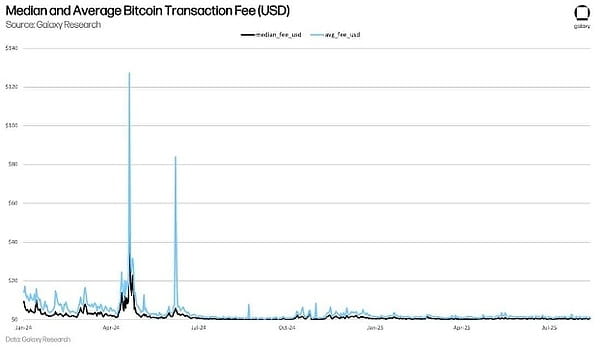
While average fees and median fees can effectively summarize market trends, they do not reflect the full picture. The following figure presents data through more refined dimensions: daily transaction fee percentiles calculated by virtual byte price (sats/vB).
The chart covers the time span from January 2023 to the present, showing the levels of transaction fees at the 10th, 25th, 50th (median), 75th, and 90th percentiles. This perspective not only reflects changes in the median but also presents a complete view of the evolution of mempool fee pressure, clearly revealing the sharp narrowing of fee disparities since the end of 2024.
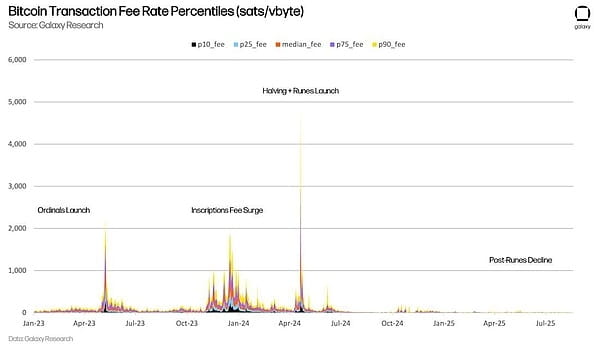
This trend is most intuitively reflected in the surge of what we define as 'free blocks' (blocks with average fees ≤ 1 sat/vB). Such blocks were nearly nonexistent in 2024, but have become increasingly common. As of the writing of this article, free blocks account for a significant proportion of daily produced blocks, fully validating the collapse of block space competition intensity.
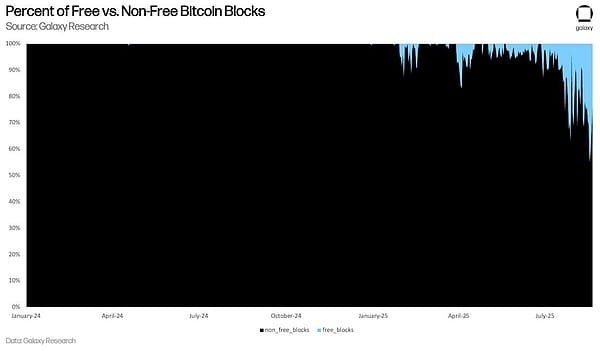
Meanwhile, the proportion of 'non-full blocks' remains high. These blocks still have room for more transactions but have not reached the limit of 4 million weight units. In short, the Bitcoin mempool (the waiting area for unprocessed transactions) often remains vacant; even when it is not empty, it is filled with transactions that can be processed quickly without paying high fees.
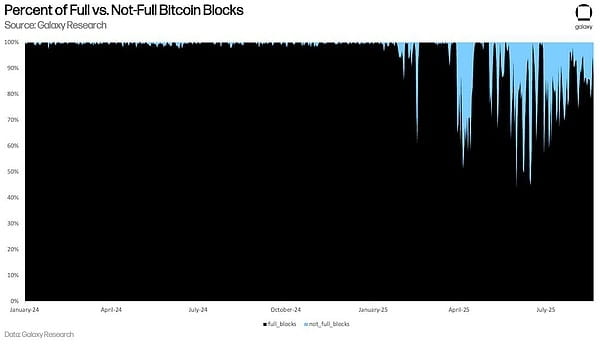
For miners, this phenomenon is concerning. The 2024 halving has reduced the reward per block to 3.125 BTC, and it was expected that transaction fees would play a more critical role in miner income, but the reality is that fee income has dried up. The long-term economic model of Bitcoin network security relies on a healthy fee market, and the current market conditions are far from 'healthy'.
The rise of custodial solutions and 'Bitcoin paper wallet' products (whether ETFs or other institutional derivatives) may be suppressing on-chain activity. Meanwhile, meme coin traders are accelerating their migration to faster and cheaper Layer 1 solutions like Solana—when the meme coin trading experience on Solana is so smooth, enduring the poor user experience of the Runes protocol clearly does not make sense.
3. OP_RETURN opcode
The Bitcoin OP_RETURN opcode was introduced in 2014, allowing users to embed up to 80 bytes of arbitrary data in transaction outputs. These outputs have verifiable unspendability, typically do not carry any BTC value, and therefore do not increase the size of the unspent transaction output (UTXO) set. UTXOs are discrete units of Bitcoin that wallets can use for future transactions, forming the foundation of the Bitcoin accounting system—each transaction consumes existing outputs and generates new outputs. If BTC is sent to an OP_RETURN output, these coins will be permanently locked, but the trade-off is a new use case: permanently storing information or metadata on the blockchain.
The usage of this script type has surged in the past 18 months. During the launch of the Runes protocol in April 2024 (block height 840,000, coinciding with the recent miner block reward halving), OP_RETURN transaction volume set a historical record. As shown in the figure below, these non-monetary transactions dominated block space during peak periods.
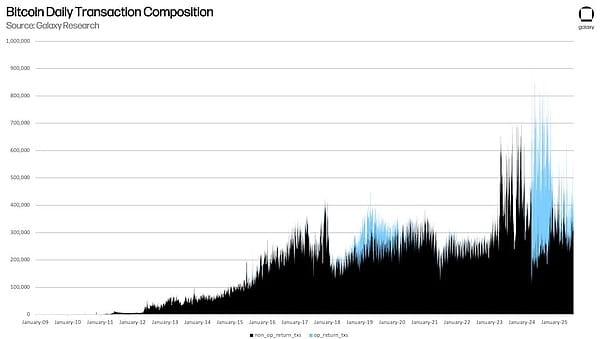
As Runes activities have cooled down, current OP_RETURN usage has gradually declined. However, developers and institutions continue to utilize it for anchoring data on-chain. For example, several weeks ago, Galaxy broadcasted a historic client transaction of 80,000 BTC via OP_RETURN.
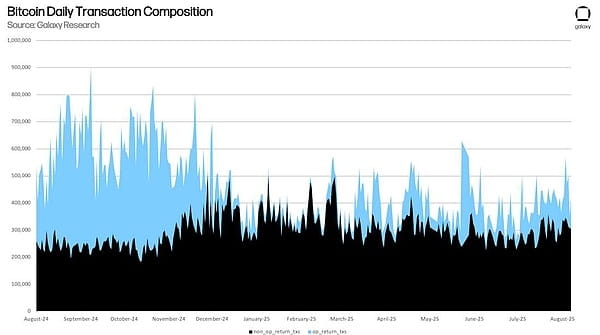
OP_RETURN is being assigned innovative uses. An organization named after the legendary Wall Street investment bank Salomon Brothers has started using OP_RETURN to send legal notices to dormant Bitcoin wallets. These on-chain messages invoke the 'abandonment principle', requiring wallet owners to respond within 90 days, or 'Salomon' (the organization holds trademark rights but is not related to Citigroup, which inherited the original investment banking business) will claim funds on behalf of clients (though how this organization controls these wallets is unclear).
While this is an innovative practice of directly anchoring legal documents with Bitcoin, it has sparked controversy in the context of the upcoming Bitcoin Core client version 30.0 update. This soon-to-be-released open-source software will relax the default restrictions on OP_RETURN data payloads, allowing a single transaction to contain larger capacities and multiple data outputs. Critics point out that while OP_RETURN outputs do not inflate the UTXO set (due to their verifiable unspendability), they still occupy block space, potentially squeezing monetary transactions and threatening the long-term sustainability of the network. The Bitcoin Core development team responded that whether to forward or package larger-scale OP_RETURN transactions ultimately rests with node operators and miners.
4. Bitcoin holdings categorized by script type
While fee trends can reflect short-term dynamics in Bitcoin, the UTXO set itself can better reveal the long-term distribution of BTC within the network. By classifying unspent outputs by script type (i.e., address format), we can observe the adoption of various types of addresses and their impact on spendability, security, and resistance to quantum computing attacks.
The P2PKH (Pay-to-PubKey-Hash) format became mainstream after the early stages of Bitcoin and still holds a significant amount of BTC (over 6 million). However, in recent years, new formats have gradually gained popularity: the P2WPKH (native SegWit) launched in 2017 has become the largest holder of unspent BTC, while the P2TR (Taproot) introduced in 2021 is steadily growing, supporting more advanced script use cases.
The following figure shows the balance distribution of each script type as of August 11. This data also provides a basis for discussions on future security risks.
The traditional P2PK (Pay-to-PubKey) format was primarily used for early coin creation transactions and is inherently susceptible to quantum computing attacks—because this format exposes the complete public key on-chain when unspent.
Other formats do not expose the public key before output spending. However, once spent (especially when addresses are reused), the public key will also be exposed, making these coins face similar risks.
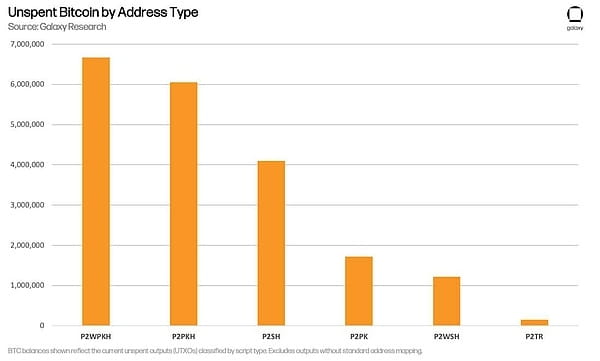
5. Conclusion
Bitcoin on-chain activity has entered a lull, but network infrastructure continues to evolve.
In the short term, low fees benefit users who wish to consolidate UTXOs or transfer assets at low cost. However, the long-term outlook is more ambiguous— the shrinkage of the fee market poses substantial doubts about network security.
Against the backdrop of block rewards reduced to 3.125 BTC, miner incentives are becoming increasingly reliant on fluctuations in organic demand. If more BTC transaction volume continues to flow to ETFs, custodial institutions, and high-speed competitive chains, the core network may become a settlement layer lacking sufficient settlement activity.
As the scale of 'Bitcoin paper wallets' expands and fee income stagnates, the security model of Bitcoin is increasingly reliant on a usage demand that is no longer assured. While fee fluctuations are not a new phenomenon, Bitcoin indeed needs more substantial reasons for on-chain usage.


